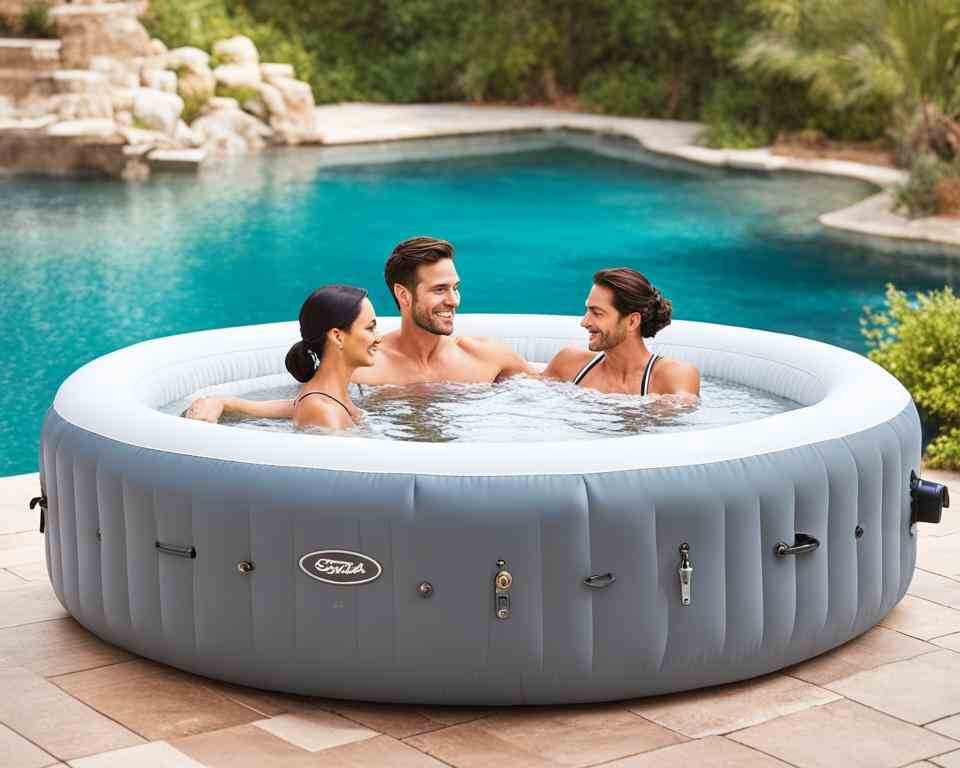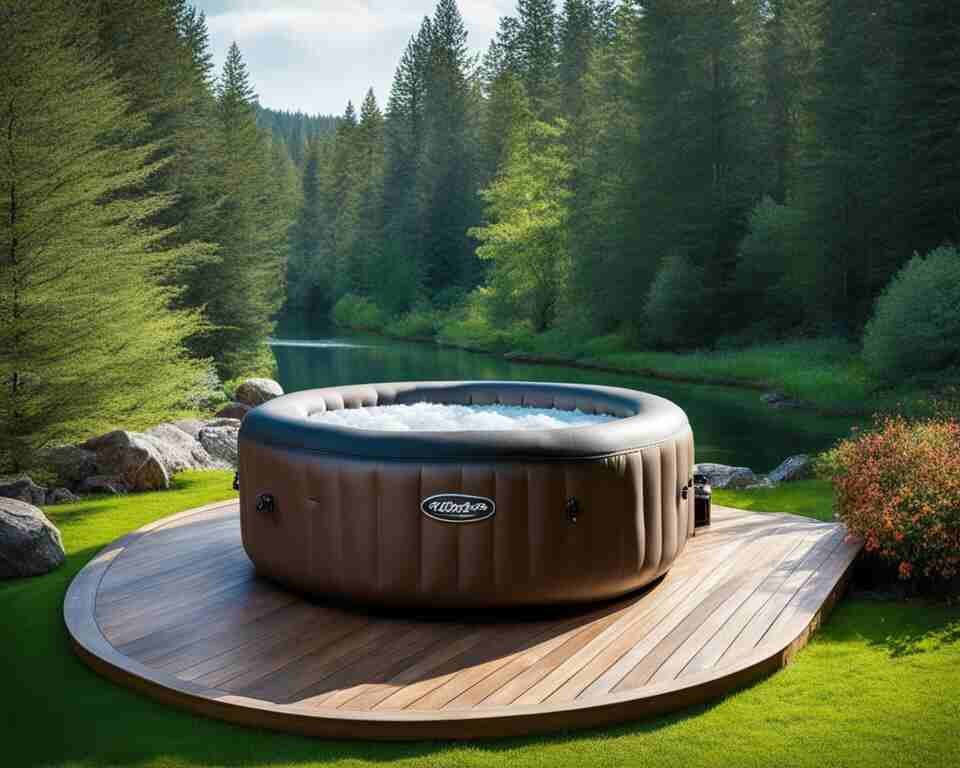When it comes to enjoying a relaxing soak in a hot tub, many people wonder if they can use saltwater in their inflatable hot tubs. Saltwater hot tubs have gained popularity for their potential therapeutic benefits and reduced chemical usage. But can inflatable hot tubs use saltwater, and is it safe to use?
In this article, I will explore the compatibility of inflatable hot tubs with saltwater systems and discuss the safety considerations involved. By the end of this post, you’ll have a clear understanding of whether saltwater is a viable option for your inflatable hot tub and whether it is safe to use.
Key Takeaways:
- Before transitioning to a saltwater tub, verify with the manufacturer to ensure that it won’t void your hot tub warranty.
- Inflatable hot tubs can be compatible with saltwater systems, but it’s important to check the manufacturer’s guidelines and specifications.
- Using saltwater in an inflatable hot tub can offer benefits such as softer skin and therapeutic effects on muscles and joints.
- It’s crucial to properly maintain salt levels and regularly clean and care for your inflatable hot tub to ensure longevity.
- Following safety guidelines and precautions is essential when using saltwater in your inflatable hot tub.
- Consider both the pros and cons of inflatable hot tubs and saltwater systems before making a decision.

Understanding Inflatable Hot Tubs and Their Design
In this section, I will provide an overview of inflatable hot tubs and their design. We will explore the rise in popularity of portable hot tub solutions and discuss the key design features that make inflatable hot tubs unique. Additionally, we will compare portable hot tubs to regular hot tubs in terms of construction and functionality.
The Rise of Portable Hot Tub Solutions
Portable hot tub solutions have experienced a significant surge in popularity in recent years. These innovative and convenient alternatives to traditional hot tubs provide a range of benefits that appeal to a wide range of individuals. Portable hot tubs offer flexibility in terms of placement, allowing you to set up your spa wherever you desire, both indoors and outdoors.
They are also lightweight and easy to transport, making them ideal for those who enjoy frequent travel or those who prefer to change the location of their hot tub within their home.

Key Design Features of Inflatable Hot Tubs
Inflatable hot tubs are known for their unique design features that set them apart from regular hot tubs. One of the most notable design elements is their inflatable nature, which allows for easy setup and takedown. The portable nature of these hot tubs is further enhanced by their lightweight construction and compact size when deflated.
Additionally, inflatable hot tubs often come with built-in digital control panels, allowing users to easily adjust temperature, jets, and other settings to create the perfect spa experience.
| Inflatable Hot Tubs | Regular Hot Tubs |
|---|---|
| Easy setup and takedown | Permanent installation |
| Compact and lightweight | Bulky and heavy |
| Adjustable digital control panels | Manual controls |
Comparing Portable and Regular Hot Tubs: Construction and Functionality
When it comes to construction, portable hot tubs are typically made from durable materials such as reinforced PVC or vinyl. These materials are designed to withstand the rigors of repeated inflation and deflation, ensuring the longevity of the hot tub. Regular hot tubs, on the other hand, are typically constructed from materials such as acrylic or fiberglass, which offer a more permanent and robust structure.
In terms of functionality, portable hot tubs often come equipped with features such as hydrotherapy jets, LED lighting, and water filtration systems to ensure a relaxing and enjoyable experience. While regular hot tubs also offer these features, their larger size and fixed installation may limit flexibility in terms of placement and maintenance.
Exploring the Benefits of Salt Water Systems in Spas
Using salt water systems in spas, including inflatable hot tubs, offers numerous benefits that contribute to a more enjoyable and therapeutic experience. From the softening effects on the skin and hair to the therapeutic advantages for muscles and joints, salt water systems can enhance the overall spa experience.
Additionally, these systems have a positive environmental impact by reducing chemical usage. Let’s explore each of these benefits in more detail.
Softening Effects on Skin and Hair
One of the key advantages of salt water systems in spas is the softening effects they have on the skin and hair. The natural properties of salt water help to moisturize the skin, leaving it feeling smooth and hydrated. Salt water also has exfoliating properties that can help to remove dead skin cells, revealing a fresher and healthier complexion.
Furthermore, the minerals present in salt water can strengthen the hair and add volume, making it look more lustrous and vibrant.
Therapeutic Advantages for Muscles and Joints
Salt water systems in spas offer therapeutic advantages for muscles and joints. The buoyant nature of salt water can help to alleviate pressure on the body, reducing strain on muscles and joints. This buoyancy can also enhance relaxation and promote a sense of weightlessness, allowing individuals to experience relief from pain and tension.
Additionally, the minerals found in salt water, such as magnesium and potassium, have been shown to have anti-inflammatory properties, which can further aid in muscle and joint recovery.
The Environmental Impact of Reduced Chemical Usage
Using salt water systems in spas can have a positive environmental impact through reduced chemical usage. Traditional spas often require the use of chlorine and other chemical sanitizers to maintain water cleanliness. However, salt water systems use a process called electrolysis to produce chlorine from the salt in the water, eliminating the need for additional chemical additives.
This not only reduces the amount of chemicals released into the environment but also minimizes the potential skin and respiratory irritations associated with traditional sanitizers.

| Benefit | Explanation |
|---|---|
| Softening Effects on Skin and Hair | Moisturizes the skin, exfoliates dead skin cells, strengthens and adds volume to hair |
| Therapeutic Advantages for Muscles and Joints | Alleviates pressure on muscles and joints, promotes relaxation, reduces inflammation |
| The Environmental Impact of Reduced Chemical Usage | Eliminates the need for additional chemical sanitizers, reduces environmental pollution |
In conclusion, salt water systems in spas, including inflatable hot tubs, offer a range of benefits. From the softening effects on the skin and hair to the therapeutic advantages for muscles and joints, individuals can enjoy a rejuvenating and relaxing experience. Moreover, the use of salt water systems contributes to a greener approach by reducing chemical usage.
If you’re looking to enhance your spa experience while minimizing environmental impact, opting for a salt water system is a wise choice.
The Pros and Cons of Inflatable Hot Tubs
When it comes to considering an inflatable hot tub, it’s important to weigh the pros and cons before making a decision. In this section, I will provide an unbiased assessment of the advantages and disadvantages of owning an inflatable hot tub.
Pros of Inflatable Hot Tubs:
1. Portability: One of the biggest benefits of inflatable hot tubs is their portability. They can be easily deflated and moved to different locations, making them a versatile option for those who like to change their setup or take their hot tub on vacation.
2. Affordability: Compared to traditional hot tubs, inflatable hot tubs are much more affordable. They offer a cost-effective way to enjoy the benefits of a hot tub without breaking the bank. Additionally, the lower upfront cost also means lower maintenance and repair costs.
3. Easy Installation: Setting up an inflatable hot tub is a breeze. Most models come with everything you need to get started, including a pump and instructions. Simply inflate the tub, fill it with water, and you’re ready to relax.
4. Versatility: Inflatable hot tubs come in a variety of shapes and sizes, allowing you to choose the perfect option for your space and needs. Whether you want a cozy two-person tub or a larger capacity for entertaining guests, there’s an inflatable hot tub to suit your preferences.
5. Comfort: Despite their inflatable design, these hot tubs offer a comfortable and enjoyable experience. Many models feature padded seats, built-in headrests, and soothing bubble jets for added relaxation.
Cons of Inflatable Hot Tubs:
1. Durability: While inflatable hot tubs are designed to be durable, they are more susceptible to punctures and leaks compared to traditional hot tubs. However, with proper care and maintenance, these issues can be minimized.
2. Heat Loss: Inflatable hot tubs may experience heat loss more quickly than their rigid counterparts. This means that the water may take longer to heat up and may cool down faster during use. Using an insulating cover can help minimize this issue.
3. Limited Jets and Features: Inflatable hot tubs typically have fewer jets and features compared to permanent hot tubs. This may result in a less customized massage experience for some users.
4. Longevity: While inflatable hot tubs can provide years of enjoyment, their lifespan is generally shorter compared to traditional hot tubs. However, proper maintenance, regular cleaning, and preventative measures can help extend their longevity.

After evaluating the pros and cons of inflatable hot tubs, it’s essential to consider your specific needs, budget, and available space. By weighing these factors, you can make an informed decision about whether an inflatable hot tub is the right choice for you.
Can Inflatable Hot Tubs Use Salt Water: Technical Considerations
When considering the use of salt water in inflatable hot tubs, there are important technical considerations to keep in mind. This section will delve into the assessment of salt water compatibility, installation and maintenance of saltwater systems, and common conversion kits for inflatable hot tubs.
Assessing Salt Water Compatibility of Inflatable Hot Tubs
Before using salt water in an inflatable hot tub, it’s crucial to assess its compatibility with the tub’s materials. Some inflatable hot tubs are specially designed to withstand the corrosive nature of salt water, while others may not be suitable for saltwater use. Check the manufacturer’s instructions or consult the product documentation to determine the salt water compatibility of your inflatable hot tub.
Installation and Maintenance of Saltwater Systems in Inflatable Tubs
Installing a saltwater system in an inflatable hot tub involves specific steps to ensure proper functioning and compatibility. It’s important to follow the manufacturer’s instructions carefully during the installation process. Additionally, regular maintenance is crucial to ensure the longevity and efficiency of the saltwater system. This may include monitoring salt levels, adjusting chemical balances, and cleaning the system components as needed.
Common Conversion Kits for Inflatable Hot Tubs to Saltwater Use
If your inflatable hot tub is not initially compatible with salt water, there are conversion kits available that can adapt it for saltwater use. These kits typically include the necessary components and instructions for converting the hot tub’s system to accommodate salt water. It’s essential to choose a conversion kit that is specifically designed for your inflatable hot tub model to ensure proper installation and performance.
To get a better understanding of the technical considerations involved in using salt water in inflatable hot tubs, refer to the table below:
| Technical Considerations | Description |
|---|---|
| Salt Water Compatibility | Determining if your inflatable hot tub is compatible with salt water based on manufacturer guidelines. |
| Installation | Following specific instructions for installing a saltwater system in your inflatable hot tub. |
| Maintenance | Performing regular maintenance tasks to ensure the proper functioning of the saltwater system. |
| Conversion Kits | Exploring available conversion kits designed to adapt inflatable hot tubs for saltwater use. |
By considering these technical aspects, you can confidently determine whether using salt water in your inflatable hot tub is feasible and ensure a smooth and enjoyable experience.
Maintenance Guide for Salt Water Inflatable Hot Tubs
Regular Monitoring and Balancing Salt Levels
A crucial aspect of maintaining salt water inflatable hot tubs is the regular monitoring and balancing of salt levels. This ensures optimal performance and prolongs the lifespan of your hot tub.
Monitoring salt levels should be done at least once a week using a saltwater test kit. The ideal salt concentration for inflatable hot tubs typically ranges between 2500-3500 parts per million (ppm), but it’s important to refer to your specific hot tub’s manual for the recommended range.
If the salt level is too low, add the necessary amount of salt to reach the desired concentration. On the other hand, if the salt level is too high, you may need to drain and dilute the water with fresh water.
Cleaning and Care for Longevity
To keep your salt water inflatable hot tub in top condition, it’s essential to establish a regular cleaning routine. Here are some key cleaning and care tips:
- Remove debris: Use a net or skimmer to remove any leaves, insects, or other debris from the water’s surface.
- Clean the filter: Regularly clean or replace the filter to ensure proper circulation and filtration of the water.
- Scrub the interior: Use a soft brush or sponge to scrub the interior surfaces of the hot tub, removing any dirt or algae buildup.
- Drain and refill: It’s recommended to drain and refill the water every 3-4 months to maintain water quality and prevent bacterial growth.
By following these cleaning and care practices, you’ll not only ensure the longevity of your hot tub but also provide a clean and enjoyable experience for every soak.
Tips on Seasonal Use and Preservation
Seasonal use and preservation are essential considerations for salt water inflatable hot tub owners. Here are some tips to keep in mind:
- Winter storage: If you live in an area with freezing temperatures, it’s vital to properly winterize your hot tub to prevent any damage. Consult your hot tub’s manual or contact the manufacturer for specific instructions.
- Regular maintenance during offseason: Even if you’re not using your hot tub regularly during certain seasons, it’s important to perform regular maintenance tasks to keep the water clean and the system functioning optimally.
- Cover usage: Always use the provided hot tub cover when the tub is not in use to protect it from debris and keep the water temperature insulated.
By following these seasonal use and preservation tips, you’ll ensure that your salt water inflatable hot tub remains in great condition and ready for use whenever you desire.
Important Safety Tips when Using Salt Water in Inflatable Hot Tubs
When using salt water in your inflatable hot tub, it’s crucial to prioritize safety to ensure a pleasant and worry-free experience. Here are some essential safety tips to keep in mind:
- Monitor Salt Levels: Regularly check the salt levels in your hot tub to maintain the optimal balance. Salt levels that are too high or too low can affect the efficiency of the salt water system and potentially cause damage.
- Proper Chemical Storage: Store the salt and other chemicals required for your hot tub in a cool, dry place, away from direct sunlight and out of reach of children and pets. Follow the manufacturer’s instructions for handling and storing chemicals.
- Test Water Quality: Use test strips or a water testing kit to monitor the water quality regularly. This helps ensure the correct balance of chemicals and prevents the growth of bacteria or algae.
- Maintain Proper pH Levels: Maintaining the proper pH levels is vital for the effectiveness of your salt water system. Test the pH levels regularly and adjust as needed to keep the water safe and balanced.
- Follow Manufacturer’s Instructions: Always follow the specific guidelines and instructions provided by the manufacturer of your inflatable hot tub. This includes recommendations for salt usage, maintenance, and any other safety precautions.
- Keep Hot Tub Clean: Regularly clean the hot tub’s interior and filters to remove any debris, oils, or residues that can affect water quality and overall performance.
- Safe Electrical Connections: Ensure that the electrical connections for your hot tub are secure and protected from water exposure. Follow the manufacturer’s instructions for installation and ensure that the electrical outlets are properly grounded.
- Safe Hot Tub Usage: Educate yourself and your family on safe hot tub usage, including guidelines for temperature limits, time limits, and safety precautions. Always supervise children and individuals with medical conditions.
By following these safety tips, you can enjoy the benefits of salt water in your inflatable hot tub with peace of mind. Remember to prioritize safety to create a relaxing and enjoyable experience for yourself and your loved ones.
Conclusion
Inflatable hot tubs offer a convenient and affordable option for relaxation and rejuvenation. Throughout this article, we have explored the compatibility of inflatable hot tubs with saltwater systems and discussed the safety considerations involved. We have also examined the benefits of using saltwater in hot tubs and provided insights into the technical aspects of saltwater adoption.
When considering whether to use saltwater in your inflatable hot tub, it is important to weigh the pros and cons. Saltwater systems can provide a softened bathing experience for your skin and hair, along with therapeutic benefits for your muscles and joints. Additionally, they offer the advantage of reduced chemical usage and a more environmentally friendly approach.
However, it is crucial to properly assess the compatibility of your inflatable hot tub with saltwater systems and follow the recommended installation and maintenance guidelines. Regular monitoring and balancing of salt levels, as well as proper cleaning and care, are essential for the longevity and performance of your hot tub. And don’t forget about the importance of following safety precautions to ensure a safe and enjoyable experience.
Ultimately, the decision to adopt saltwater in your inflatable hot tub rests on your personal preferences and needs. By considering the information presented in this article, you can make an informed choice that aligns with your relaxation and health goals. Whether you choose to use saltwater or stick to traditional methods, an inflatable hot tub can be a wonderful addition to your home or outdoor space, providing endless hours of relaxation and enjoyment.

